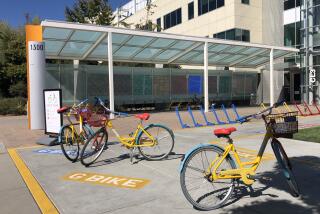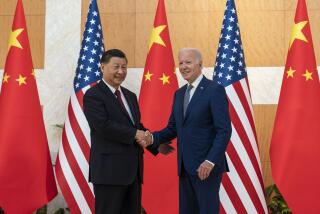Prospects Bright for Bush’s Competitiveness Plan
WASHINGTON — A year ago, President Bush’s top domestic priority was a Social Security overhaul. It sank amid a partisan firestorm.
This year, in contrast, his new American Competitiveness Initiative is triggering a stampede of bipartisan support. It could be one of the few administration initiatives to be enacted in this congressional election year.
With last year’s Social Security push all but abandoned, Bush’s domestic focus now is a much less ambitious effort: to prevent the United States from falling behind economic competitors in Asia and elsewhere, by providing federal support for math and science education and for basic research in the physical sciences.
In a typical comment in favor of the initiative, Rep. C.A. Dutch Ruppersberger (D-Md.) said at a House hearing last week: “We need to all roll up our sleeves in a big way.”
The sour notes have been few and have come largely from critics who wish Bush’s initiative had been more ambitious.
The White House “has not put its money where its mouth is on improving American competitiveness,” said Montana’s Max Baucus, the top Democrat on the Senate Finance Committee.
Bush’s long-range plan calls for doubling the government’s annual spending on physical science research over the next decade, from $9.8 billion this year to $19.5 billion in 2016. Bush’s 2007 budget, sent to Congress last week, would provide a down payment of $910 million, an increase of 9.3%.
The administration also would provide $380 million in new money next year for math and science education. The goals include training 70,000 additional teachers of advanced high school math and science courses, and persuading 30,000 math and science professionals to become adjunct high school teachers. Money would also go toward preparing elementary school students for rigorous high school mathematics.
For next year, the administration says it has budgeted $5.9 billion for the competitiveness initiative. But $4.6 billion of that is to resuscitate the tax credit that businesses had used to write off research and development costs. The credit expired Dec. 31; business has long sought to have it made permanent.
That leaves $1.3 billion in new spending -- about what the government spends in Social Security benefits every 20 hours -- to begin training teachers and supporting research through the National Science Foundation, the Energy Department’s Office of Science and the National Institute of Standards and Technology.
Bush’s competitiveness initiative requires some trade-offs.
Hamstrung by huge deficits, the president would freeze the budget of the National Institutes of Health, meaning that funding for biological research would not keep pace with inflation. Although annual NIH spending has doubled in recent years, “the problem is that once you stop increasing the NIH budget, you throw overboard some of the benefits you’ve laid the foundation for,” said Barry Toiv, communications director for the Assn. of American Universities, a group of 62 top research schools.
Bush also proposed freezing the maximum federal Pell Grant for needy college students at $4,050 a year -- the same level it has been since 2002, although more students would be eligible next year than under this year’s budget. TRIO programs, to help disadvantaged students get through college, would be cut from $828 million to $380 million.
The administration also asked Congress to close the Commerce Department’s $83-million Advanced Technology Program -- grants to businesses to develop new technologies for commercial use -- on grounds that private money was available.
“We think we can be more efficient,” Commerce Secretary Carlos M. Gutierrez said. “Some cuts are good.”
Not everyone is so sure.
“We’re delighted with the president’s identification of competitiveness as an issue,” said Terry W. Hartle, a senior vice president of the American Council on Education, an organization of about 1,800 universities and related institutions. “But the budget deficit makes it difficult to carry through. Accomplishing what the president wants won’t be done without a lot of money.”
Some business groups see Bush’s proposal as half-full, not half-empty.
The National Assn. of Manufacturers “heartily” supports Bush’s plan, said David Peyton, the group’s director of technology policy.
In a recent survey of association members, 80% reported a shortage of qualified workers, a situation that Peyton said Bush’s plan would help remedy. But Peyton lamented the prospective loss of the Advanced Technology Program, which he credited with development of the digital mammography machine.
“I’m awfully pleased that there seems to be an awakening to this issue,” said Norman R. Augustine, retired chairman and chief executive of Lockheed Martin.
Regarding Bush’s competitiveness initiative, Augustine said: “All of us who have been involved in this think he’s on the right track.”
Augustine became formally involved when Sens. Lamar Alexander (R-Tenn.) and Jeff Bingaman (D-N.M.) asked a panel Augustine led at the National Academy of Sciences to study the challenges to American technological dominance and to evaluate possible responses.
The Augustine panel’s report, soon to be published in a book called “Rising Above the Gathering Storm,” is the force behind the leading congressional competitiveness proposal, introduced by Alexander, Bingaman and Sens. Pete V. Domenici (R-N.M.) and Barbara A. Mikulski (D-Md.), with 58 cosponsors.
Their three-bill package includes many provisions not in the Bush initiative. It would offer 10,000 potential math and science teachers up to $20,000 a year for college expenses, then $10,000 a year if they committed to teaching math or science for five years in public schools with low-income students.
The proposal would also offer summer internships to students and teachers at national laboratories and research institutions.
One of the bills is in the jurisdiction of the Senate Health, Education, Labor and Pensions Committee, whose chairman, Michael B. Enzi (R-Wyo.), is among many people worried about competition from Asia.
He rattles off statistics: that China produced about 500,000 engineering graduates in 2004 and India turned out 200,000, compared with the U.S. total of 70,000; that only 7% of American children in the fourth and eighth grades scored at the advanced level in a 2003 math and science study, compared with 38% of fourth-graders and 44% of eighth-graders in Singapore.
“There’s a consensus that we should play a major role in math and science education,” said Senate Budget Committee Chairman Judd Gregg (R-N.H.). But yet to be determined, he said, is whether the government should single out the best students and the ones likely to become teachers, or try to help everyone.
More to Read
Get the L.A. Times Politics newsletter
Deeply reported insights into legislation, politics and policy from Sacramento, Washington and beyond. In your inbox three times per week.
You may occasionally receive promotional content from the Los Angeles Times.











